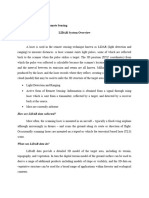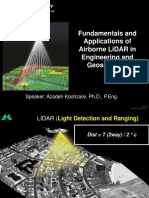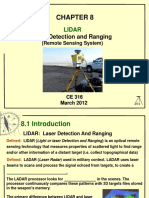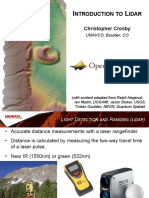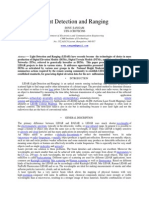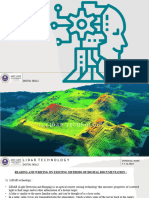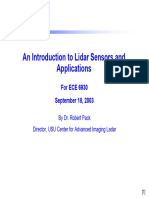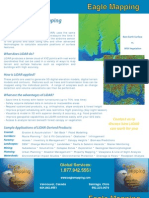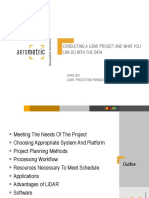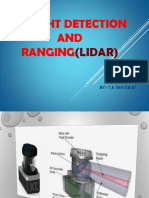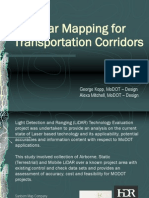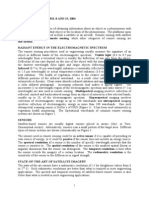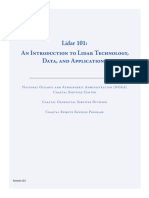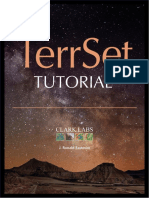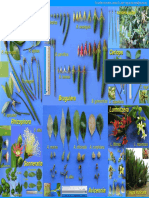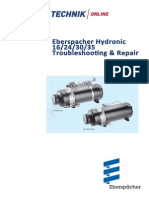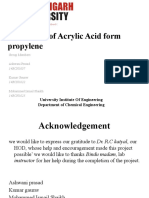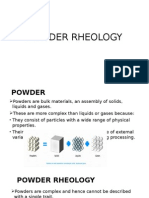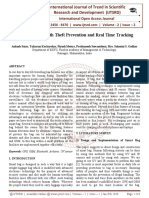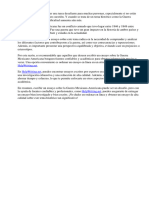Introduction to LiDAR Remote Sensing
Introduction to LiDAR Remote Sensing
Ohio URISA LiDAR Workshop, Thursday June 24, 2010
Dr. Hongxing Liu
Director, Center for Geospatial Information &
Environmental Sensor Networks (GIESN)
Professor, Department of Geography
University of Cincinnati
Cincinnati, OH 45221-0131
Email: Hongxing.Liu@uc.edu
http://www.geography.uc.edu/
http://giesn.uc.edu
Phone:513-5563451
Introduction to LiDAR Remote Sensing
Lecture: LiDAR remote sensing and LiDAR data processing
Instructor: Dr Hongxing Liu
1.
2.
3.
4.
5.
6.
7.
Basic components of LiDAR system
LiDAR elevation data and intensity data
Digital Surface Model, Canopy Height Model and bare earth DEM
LiDAR data sources
Different types of LiDAR systems
LiDAR data format and data conversions
Applications of LiDAR in hydrological and environmental studies
Introduction to LiDAR Remote Sensing
Exercises:
Instructors: Mr. Haibin Su,
Mr. Qiusheng Wu, Mr. Ben Thomas
Ex #1: Creation of LiDAR elevation grid and visualization: spatial
interpolation, noise filtering, contour map, continuous or classified
choropleth maps, hill-shading relief map, draping image on LiDAR.
Ex #2: Viewshed and Watershed Analysis: campus visibility given a view
point, water flowpath, water flow direction, stream network, watershed
delineation
Ex #3: Volumetric Change Analysis and Feature Extraction: coastal
erosion and deposition volumes, buildings and tree extraction
Software: ESRI's ArcGIS, ArcScene, Spatial Analyst, and 3D
Analyst
�Active Remote Sensing System
LIDAR
LiDAR is an acronym for LIght
Detection And Ranging
An active remote sensing technology.
As a non-image nadir-looking active
sensor, laser sensor obtain digital
topographic data of high accuracy by
measuring the round-trip time of laser
pulses reflected from the Earths
surface.
Active airborne sensor emits several
thousand infrared laser pulses per
second. If location and orientation of
laser scanner is known, can calculate a
range measurement for each recorded
echo from a laser pulse
LiDAR Remote Sensing System
LiDAR Remote Sensing System
Three components
Integration of three
technologies for
acquisition of precise
position and orientation
of active laser beams:
Laser Scanning
System
Differential global
positioning systems
(DGPS)
Inertial navigation
systems
(INS)/Inertial
Measurement Unit
(IMU)
GPS satellites
GPS
x (roll)
y (pitch)
z (yaw)
IMU
Laser beam
footprints
GPS station
GPS Satellite
z
y
x
Aircraft installation
Mission operation
Parameters
30
GPS
Ground Station
Cessna 206
Partenavia P-68 Observer
Flight height
975 m AGL
(3200 ft)
Swath width
About 594 m
30 km radius
1.5 m spacing
444,000 points/km
King Air A-90
30% side overlap
between swaths
�LiDAR Remote Sensing System
Laser Scanning System
The laser scanning system can pulse as fast as 10,000 times per second
(10 KHz) and record the range and backscatter intensity of the first
and last laser returns of each laser reflection.
By measuring the round trip travel time of the laser pulse from the
aircraft to the ground, a highly accurate spot elevation can be
calculated. By scanning the laser pulses across the terrain using a
rotating mirror, a dense set of distances to the surface is measured
along a narrow corridor: range & angle of laser beam
LiDAR Remote Sensing System
DGPS
The onboard GPS receiver locates an X,Y, Z
position for each laser pulse return.
The airplane position along its entire flight
path is determined using the DGPS,
Differentially corrected
Positional accuracy: 5-10 cm
GPS base stations must be operating during
the lidar survey (optimal time frame: starting
30min before takeoff running until 30min
after landing of the aircraft)
Best if survey aircraft stays within 30 to 50km
of one base station at all times
Base station and aircraft GPS files are merged
to obtain a differentially corrected solution for
the aircraft trajectory
LiDAR Remote Sensing System
INS/IMU
an inertial navigation system (INS)
monitors the attitude (pitch, roll, and yaw
angles) of the laser sensor.
The direction of the laser pulse is
determined using an Inertial Navigation
System (INS) that measures the orientation
of the airplane, and measurements of the
orientation of the scan mirror.
Utilize gyroscopes and accelerometers
Orientation (pitch/roll) accuracy : ~ 0.005
Types of LiDAR Systems
Terrestrial Topographical LiDAR systems
Single return LiDAR
Multiple returns LiDAR
Waveform LiDAR
Marine Bathymetric LiDAR
SHOALS
CHARTS
Topographical/Bathymetric LiDAR
EAARL
�Types of LiDAR Systems
Types of LiDAR Systems
1980s airborne lidar profilers
Early 1990s profilers gradually replaced by scanners;
Early version of laser altimeters measured the distance to the first
feature reflecting the laser pulse. In areas of dense vegetation that is
usually the top of the vegetation canopy. More recent laser altimeter
systems measure multiple returns for each laser pulse. The last
return for each pulse is used to map the bare-earth topography.
ALS50: 83 kHz maximum pulse rate with four-return range detection
system (1st, 2nd, 3rd and last)
Optech ALTM 3100: pulse rates as high as 100 kHz at 1,100 m
altitude (33 kHz at 3,500 m)
TopoSys Falcon: 83KHz, first and last returns (linearly disposed glass
fiber bundle)
Types of LiDAR Systems
Terrestrial Topographical LiDAR systems
Single return LiDAR
Single return from
top of vegetation
canopy and
buildings
Interpolation of raw
laser
measurements
result in a digital
surface model
Types of LiDAR Systems
Terrestrial Topographical LiDAR systems
Multiple returns LiDAR
Terrestrial Topographical LiDAR systems
Multiple returns LiDAR
Multiple returns of
laser signal
1st return
from tree top
Vegetation canopy
height
Bare-earth DEM by
vegetation canopy
removal
2nd return
from
branches
3rd return
from
ground
1st return
from tree top
1st (and only)
return from
building
2nd return
from branches
3rd return
from ground
�Types of LiDAR Systems
Terrestrial Topographical LiDAR systems
Waveform LiDAR
records the entire return waveform from the laser pulse.
Laser Waveform Re-tracking
Laser pulse spread
Waveform re-tracking
Vegetation canopy
height
=distance between
first and last
peaks
Bathymetric LIDAR Systems
JALBTCX, UACE
SHOALS
Scanning Hydrographic
Operational Airborne Lidar
Survey (SHOALS) system
Up to 50 m depth
CHARTS
Airborne LiDAR scanning is
integrated with hyperspectral
imaging
2-4 m resolution bathymetric data
2 m resolution hyperspectral image
Bathymetric LIDAR System
Shallow coastal waters
Bathymetric Lidar
Up to 50-70 m deep
2 to 4 m sampling
spacing
15 cm depth
accuracy and 2 m
horizontal accuracy
Topographic/Bathymetric LiDAR-EAARL
USGS & NASA
EAARL (Experimental Advanced Airborne Research Lidar) system
Both topographic and bathymetric measurements: single green laser,
full waveform
Up to 20 m deep water
River channels, streams bathymetry
Shallow coastal waters
�Satellite Laser Altimeter
NASA currently has two satellite missions
planned that will carry laser altimeters: the
Vegetation Canopy Lidar mission (VCL) and the
Geosciences Laser Altimeter Systems (GLAS).
The Geoscience Laser Altimeter System (GLAS),
presently under development, will fly on board of
ICESAT in a near-polar orbit in 2001. GLAS will
measure the elevations of the Earth's ocean, ice
sheets and land, the height of clouds, with
unprecedented accuracy and global coverage.
Laser pulses will illuminate spots (footprints) 70
meters in diameter, spaced at 170-meter intervals
along Earth's surface. Over most of the ice
sheets, the accuracy of each elevation
measurement will be 15 cm. Over land, the
vertical accuracy of the elevation measurements
will be better than a meter in regions of low slope
and up to 10 m in regions of large slopes.
LiDAR Data
Ground scanning pattern
Elliptical spiral
Swing mode
Z-shaped
LiDAR Data Accuracy
Vertical accuracy: 2 13 cm, with mean error of 6 cm (Jensen,
2000, with reference to Vaughn, 1996)
10 cm compared to surveyed runway elevation (Jensen, 2000, with
reference to Krabill, 1995)
Horizontal accuracy not as good as vertical accuracy (e.g., less than
50 cm)
Factors affecting LIDAR accuracy:
Timing accuracy
Range dispersion within the laser footprint
Range walk due to backscatter strength variations
Multipath errors
Synchronization errors among the data streams
LiDAR Data Accuracy
USGS DEM vs LiDAR DEM
1000 ft.
USGS DEM
Widely used
Moderate resolution (30m)
7m vertical accuracy
LIDAR bare-earth DEM
Limited availability
High resolution (1m 5m)
15cm accuracy
�LiDAR Data Accuracy
LiDAR Data Cost
USGS DEM vs LiDAR DEM
30 m
10 m
1m
LiDAR Data
LiDAR Data Processing
LiDAR Measurements
Each LIDAR pulse measurement is individually georeferenced. Lidar
point coordinates are calculated by integrating the position and
orientation of the platform, with the scanning angles and distance
measurement from the laser.
Measurements include:
1. Range (height) measurements of multiple echoes (x, y, z)
2. Reflectivity (intensity) of the target (DN)
Intensity data
Filtering, Classification and Surface Modeling
Intensity feature offered on some sensors records how much energy is
reflected by the object
Intensity return data are enabling automatic extraction of objects (e.g
buildings) in data processing
Output image can be used to assist in processing of LiDAR points (e.g.
identifying between features using breaklines)
Enhanced with breaklines, which are compiled from existing
photogrammetric or digitized from intensity images
�LiDAR Intensity
LiDAR Data
LIDAR heights
File format
Points
ASCII format ( .xyz, .txt)
LAS (.las)
Grids
ASCII (.asc)
ArcGIS grids, GeoTIFF
LIDAR intensity
LiDAR Data
ENVI 4.1 has .las reading function
LiDAR Data
ENVI 4.1 has .las reading function
�Massive LIDAR Data set
LIDAR Points
Lidar Point Cloud of Structures
LiDAR Data
Point Clouds of raw measurements
LiDAR Software
Free Software for LiDAR point clouds
PFM Area Based Editor
Developed by Jan Depen at JALBTCXThe
area based PFM data structure, combined with powerful 3D visualization
tools and area based automated processing, highly efficient and effective
process.
�LiDAR Data Sources
Available LiDAR data
Nationwide LiDAR data from NOAA Coastal Service Center
http://csc-s-mapsq.csc.noaa.gov/dataviewer/viewer.html?keyword=lidar
USGS CLICK (Center for LiDAR Information Coordination and
Knowledge)
http://lidar.cr.usgs.gov/
Ohio statewide LiDAR data from OSIP (Ohio Statewide Imagery
Program)
http:/gis1.oit.ohio.gov/geodatadownload/osip.aspx
Open topography Portal
http://www.opentopography.org
NCALM (NSF LiDAR data distribution center)
http://calm.geo.berkeley.edu/ncalm/ddc.html
LiDAR Data Sources
Available LiDAR data
USGS CLICK (Center for LiDAR Information Coordination and
Knowledge)
http://lidar.cr.usgs.gov/
LiDAR Data Sources
Available LiDAR data
Nationwide LiDAR data from NOAA Coastal Service Center
http://csc-s-mapsq.csc.noaa.gov/dataviewer/viewer.html?keyword=lidar
LiDAR Data Sources
Available LiDAR data
Ohio statewide LiDAR data from OSIP (Ohio Statewide Imagery
Program)
http:/gis1.oit.ohio.gov/geodatadownload/osip.aspx
10
�LiDAR Data Sources
Available LiDAR data
Ohio statewide LiDAR data from OSIP (Ohio Statewide Imagery
Program)
http:/gis1.oit.ohio.gov/geodatadownload/osip.aspx
LiDAR Data Sources
Available LiDAR data
NCALM (NSF LiDAR data distribution center)
http://calm.geo.berkeley.edu/ncalm/ddc.html
LiDAR Data Sources
Available LiDAR data
Open topography Portal
http://www.opentopography.org
LiDAR Software
Free Software for LiDAR point clouds
OpenTopography 2.0 (OT 2.0)
OpenTopography released LiDAR point cloud access and processing
system: OpenTopography 2.0 (OT 2.0).
LViz: 3D LiDAR Visualization Tool (http://lidar.asu.edu/LViz.html)
LViz is a tool developed designed for 3D visualization of LiDAR / ALSM
point and interpolated data, the tool offers import of LiDAR point cloud
data (delimited text file) or interpolated surfaces (in ascii or arc ascii grid
formats).
GEON Points2Grid Utility (http://lidar.asu.edu/points2grid.html)
The GEON Points2Grid Utility is a lightweight tool for the generation of
Digital Elevation Models (DEMs) from LiDAR point cloud data. The
Points2Grid Utility is a Windows application that utilizes the same local
binning algorithm deployed in the OpenTopography LiDAR system to
offer rapid generation of DEMs from large volumes of LiDAR point
return data.
11
�LiDAR Software
Free Software for LiDAR point clouds
LAStools (http://www.cs.unc.edu/~isenburg/lastools/)
A powerful, free set of command line utilities for converting, viewing, compressing,
and performing other processing tasks for LIDAR data in LAS format.
libLAS - LAS 1.0/1.1/1.2 ASPRS LiDAR data translation toolset (http://liblas.org/)
libLAS is a C/C++ library for reading and writing the very common LAS LiDAR
format. The ASPRS LAS format is a sequential binary format used to store data
from LiDAR sensors and by LiDAR processing software for data interchange and
archival. libLAS builds upon by Martin Isenburg and Jonathan Shewchuk of
LLNL/UC Berkeley in their LAStools project to do a number of things.
GDAL (Geospatial Data Abstraction Library) http://www.gdal.org/
An open source translator library and command line utilities for raster geospatial
data formats. GDAL is very helpful for file format conversions, re-projection, and
many other DEM management and processing tasks.
PROJ4 (Cartographic Projections Library) http://trac.osgeo.org/proj/
A powerful (and challenging) set of libraries and command line utilities for map
projection. PROJ4 is handy for tasks like mass re-projection of ascii LiDAR point
cloud data.
Lidar Processing Flow Chart
LiDAR Software
Free Software for LiDAR DEMs
River Bathymetry Toolkit (RBT)
(http://www.fs.fed.us/rm/boise/AWAE/projects/river_bathymetry_toolkit.sht
ml)
A suite of GIS tools for processing high resolution DEMs of channels. The
goal is to characterize in-stream and floodplain geomorphology to
support aquatic habitat analyses and numerical models of flow and
sediment transport. Developed by the Air, Water and Aquatic
Environments Science Program at the US Forest Service Rocky Mountain
Research Station and ESSA Technologies. The RBT is available for free
and is under active development.
Information from LiDAR data
LIDAR Data
First return
Last return
Intensity
Bare Earth Extractor
First return (optional)
Last return (required)
Automatically clean data before extracting bare earth
Spikes and pits removal
Low pass filter smoothing
Building Extractor
Last return DEM
Bare-earth DEM
Minimum building area
Minimum building height
Maximum slope for building roofs
Smoothing tolerance (Bezier smooth)
Z-enable using (combo box lists options min, max, average, actual, none)
Square up (enabled by default)
Extract as multi-components. (Lego-land buildings)
12
�Information from LiDAR data
Building Attributes
Building ID
Roof type multi-level flat, simple flat, complex, pitched
Average height above ground level
Min height above ground level
Max height above ground level
Dev height range of height
Area
Perimeter
Length
Width
Orientation angle
Information from LiDAR data
Bare Earth Clean Up Tools and Pitts Removal
Input DEM
Percentage of DEM range above which spikes appear
Outer radius of search annulus
Inner radius of search annulus
Show detached spikes and pits as a shape file
Bare Earth Modification Tools
Create Bare Earth Modification Layer
process Bare Earth Modifications
Replace Buildings
Create 3D Shapes Tool
Input shape file
Z attribution method - min, max, average, actual
DEM file
Square Tool
Input building shape file
Smoothing tolerance
Digital elevation model
Bare-earth
Polygon Reshape Deluxe Editing Tool
Image Cut Tool
Information from LiDAR data
Tree and Forest Extractor
First return (optional)
Last return (required)
Bare-earth (required)
Buildings (required)
Output type:
Tree points or
Forest polygons
Minimum tree height
Average tree diameter
Max dist between trees (for forests)
Min size of a forest (for forests)
Attributes:
Tree ID
Tree Height
Crown width of tree
Stem diameter
Digital Surface Model (DSM)
DSM
Raw LiDAR
signals are
reflected from
trees, buildings,
and the
grounds
Interpolation
results in a
digital surface
model
Vegetation
canopy model,
3D urban
models
13
�Digital Surface Model (DSM)
DSM
Raw LiDAR
signals are
reflected from
trees, buildings,
and the
grounds
Digital Surface Model (DSM)
DSM
Interpolation
results in a
digital surface
model
Vegetation
canopy model,
3D urban
models
Digital Surface Model (DSM)
DSM
Digital Surface Model (DSM)
DSM
14
�Bare-Earth DEM
Classifying laser scanning point clouds:
Vegetation
Man made structures (buildings)
Bare earth
Error points
Bare-Earth DEM
Bare Earth DEM
Bare Earth is the modeling of terrain with all elevated features
(typically buildings and trees) removed.
Bare earth is critical for effectively modeling and displaying the
buildings and tree volumes on an accurate real-world terrain.
In order to extract bare earth, edges are detected from the last return
elevation data and areas of sharp change in elevation, for example,
the edges of buildings and trees, are picked out and removed from the
original images.
Bare-Earth DEM
Bare Earth DEM
Bare Earth is the modeling of terrain with all elevated features
(typically buildings and trees) removed.
Bare earth is critical for effectively modeling and displaying the
buildings and tree volumes on an accurate real-world terrain.
In order to extract bare earth, edges are detected from the last return
elevation data and areas of sharp change in elevation, for example,
the edges of buildings and trees, are picked out and removed from the
original images.
Bare-Earth DEM
Bare Earth DEM
Large buildings
Imperfect removal
Houses & trees
artifacts
15
�Bare-Earth DEM
Bare Earth DEM
Canopy Removal to Bare Earth
Single return with manual editing or automated algorithm
Multiple returns with automated algorithm to remove canopy
Bare-Earth DEM
Bare Earth DEM
Canopy Removal to Bare Earth
Single return with manual editing or automated algorithm
Multiple returns with automated algorithm to remove canopy
LIDAR bare-earth DEM
Limited availability
High resolution (1m 5m)
15cm accuracy
Digital Building Model (DBM)
Digital Building Model (DBM)
Digital Building/Object Model
Although LIDAR data sets contain vast amounts of 3D information,
terrain and cultural features such as buildings, trees, power lines, and
many other visible features must be extracted.
Automatically extracts 3D terrain, buildings, trees, and forest features
from airborne LIDAR.
Digital Building/Object Model
Building Footprints: extracts 3D building footprints as simple
building models from airborne LIDAR data.
Building attributes of height, area, perimeter, average height and
building roof type (pitched, simple, etc.) are also automatically
collected.
Automatically extracts attributes of features, such as building height,
area, perimeter, roof type, tree crown width, and tree stem diameter.
DBM=DSM-DEM
DBM=DSM-DEM
16
�3D Urban Modelbased on DBM
Digital Building Model (DBM)
Digital Building/Object Model
DBM=DSM-DEM
Downtown Houston
Highway Models in Houston
Canopy Height Model (CHM)
CHM
CHM=DSM-DEM
LiDAR Applications
Volumetric study landfill calculations
Transmission lines studies
line of sight analysis
Floodplain mapping or coastal analysis
Homeland security emergency management
17
�LiDAR Applications
Lidar Provides a Wealth of Information for National Applications
LiDAR Applications
Forestry
Direct measurements:
Height
Number of trees
+
Crown diameter
Canopy structure
NIR multispectral image
Estimated through regression: Lidar CHM
Volume
Biomass
Carbon storage
LAI (leaf area index)
Etc.
LiDAR Applications
Urban Planning
LiDAR Applications
Utility Mapping
18
�LiDAR Applications
Topographical Mapping
LiDAR Applications
Floodplain Mapping
Color IR Photography Draped
On Lidar DEM
USGS DTM
LIDAR DTM
Storm-Surge
Inundation
LiDAR Applications
Floodplain Mapping
9.5-ft Storm Surge
Viewshed Analysis
Surface visibility
The analysis uses the elevation value of
each cell of the DEM to determine
visibility to or from a particular cell.
Terrain features will hide a point if their
elevation values are higher than the line
of sight between the viewing point and
target point
The visibility from surrounding terrain
positions can be summed to give a
cumulative sense of how many times a
place is seen.
It assembles all the areas where the line
of sight is rising as the rays move
outwards.
19
�Viewshed Analysis
Surface visibility
Observer:
A point, set of points, or polyline
Target:
Typically every cell in DEM
Assigned 1 if it is visible, 0 if not
Line of Sight Model
Position (elevation) of observer
Position (elevation) of target
Intervening landforms
Changing Position
If the observer moves, viewshed changes
Viewshed Analysis
Viewshed Determination based on constraints
Additional Parameters
Watershed Delineation
Watershed Delineation
Watershed
Watershed
An area that contributes flow to a
point on the landscape
Water falling anywhere in the
upstream area of a watershed will
pass through that point.
May be small or large
Identified from a flow direction
surface
Drainage network
A set of cells through which surface
water flows
Based on the flow direction surface
20
�Watershed Analysis
Automatically Deriving Stream Network and
Watersheds based on LIDAR DEM
32
ArcGIS
64
16
8
128
1
Flow
accumulation
Flow direction
Elevation Model
Flow Direction
Watersheds
Surface Volume Calculation
Flow Accumulation
Stream
network
Cut and Fill Volumetric Calculation
Cut and fill calculation is often performed by civil engineers to
establish road or railroad routes and gradients that minimize the
movement of earth.
It is generally most economical to balance the amount of material
removed from the high areas (cut) with the amount of material
required to fill low areas (fill).
The volume of material related to cutting and filling.
21
�Cut and Fill Volumetric Calculation
Applications
road or railroad constructions
Landscaping and artificial terrain
Construction of golf courses
Reservoir capacity estimation
ice volume estimation
Coastal erosion and deposition
Hurricane damages
Coastal morphological change analysis
Object-oriented method
Cut and Fill Volumetric Calculation
Applications
LiDAR Remote Sensing
Information for Learning
http://giesn.uc.edu/workshops/lidar
22
�LiDAR Remote Sensing
Information for Learning
Videos
What is LiDAR? (movie .flv format)
LiDAR 101 (movie .MP4 format)
LiDAR applications (movie MP4 format)
Aerotec LiDAR capability (movie MP4 format)
LiDAR Analyst software (movie MP4 format)
Useful websites
LIDAR tutorial at the University of Idaho
http://www.cnrhome.uidaho.edu/default.aspx?pid=90302
LIDAR primer from Geospatial Solutions
http://www.geospatialsolutions.com/geospatialsolutions/article/articleDetail.jsp?id=10275
Airborne Topographic Mapper at Wallops Island, Goodard Space Flight
Center
http://atm.wff.nasa.gov/
An overview article on Geodetic Laser Scanning in Physics Today
http://ptonline.aip.org/getpdf/servlet/GetPDFServlet?filetype=pdf&id=PH
TOAD000060000012000041000001&idtype=cvips
Department of Geography
23


